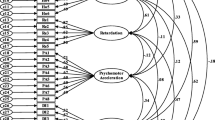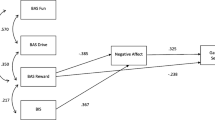Abstract
We explored cross-sectionally the roles in bipolar spectrum symptomatology of two broad motivational systems that are thought to control levels of responsiveness to cues of threat and reward, the Behavioral Inhibition System (BIS) and the Behavioral Activation System (BAS). Undergraduate students (n = 357) completed questionnaires regarding (a) bipolar spectrum disorders [the General Behavior Inventory (GBI), a well-established clinical screening measure], (b) current depression and mania symptoms (the Internal State Scale; ISS), and (c) BIS/BAS sensitivities (the BIS/BAS scales). Validated cutoff scores on the GBI were used to identify individuals at risk for a mood disorder. It was hypothesized that, among at-risk respondents, high BAS and low BIS levels would be associated with high current mania ratings, whereas low BAS and high BIS would be associated with high current depression ratings. Multiple regression analyses indicated that, among at-risk individuals (n = 63), BAS accounted for 27% of current mania symptoms but BIS did not contribute. For these individuals, BAS and BIS were both significant and together accounted for 44% of current depressive symptoms.
Similar content being viewed by others
REFERENCES
Ahrens, B., Grof, P., Moller, H.-J., & Muller-Oerlinghausen, B. (1995). Extended survival of patients on long-term lithium treatment. Canadian Journal of Psychiatry, 40, 241–246.
Allen, J. J., Iacono, W. G., Depue, R. A., & Arbisi, P. (1993). Regional electroencephalographic asymmetries in bipolar seasonal affective disorder before and after exposure to bright light. Biological Psychiatry, 33, 642–646.
Bauer, M. S., Crits-Christoph, P., Ball, W. A., Dewees, E., McAllister, T., Alahi, P., Cacciola, J., & Whybrow, P. C. (1991). Independent assessment of manic and depressive symptoms by self-rating: Scale characteristics and implications for the study of mania. Archives of General Psychiatry, 48, 807–812.
Bolger, N., & Zuckerman, A. (1995). A framework for studying personality in the stress process. Journal of Personality & Social Psychology, 69, 890–902.
Brown, G., & Harris, T. O. (1986). Establishing causal links: The Bedford College studies of depression. In H. Katschnig (Ed.), Life events and psychiatric disorders: Controversial issues (pp. 107–187), Cambridge, England: Cambridge University Press.
Carver, C. S., & Scheier, M. F. (1998). On the self-regulation of behavior. New York: Cambridge University Press.
Carver, C. S., & White, T. L. (1994). Behavioral inhibition, behavioral activation, and affective responses to impending reward and punishment: The BIS/BAS scales. Journal of Personality and Social Psychology, 67, 319–333.
Carver, C. S., Lawrence, J. W., & Scheier, M. F. (1996). A control-process perspective on the origins of affect. In L. L. Martin & A. Tesser (Eds.), Striving and feeling: Interactions among goals, affect, and self-regulation (pp. 11–52). Mahwah, NJ: Erlbaum.
Clark, L. A., Watson, D., & Mineka, S. (1994). Temperament, personality, and the mood and anxiety disorders. Journal of Abnormal Psychology, 103, 103–116.
Cloninger, C. R. (1986). A unified biosocial theory of personality and its role in the development of anxiety states. Psychiatric Developments, 3, 167–226.
Cohen, J., & Cohen, P. (1983). Applied multiple regression/correlation analysis for the behavioral sciences. Hillsdale, NJ: Lawrence Erlbaum Associates.
Coryell, W., Scheftner, W., Keller, M., & Endicott, J. (1993). The enduring psychosocial consequences of mania and depression. American Journal of Psychiatry, 150, 720–727.
Depue, R. A., & Iacono, W. G. (1989). Neurobehavioral aspects of affective disorders. Annual Review of Psychology, 40, 457–492.
Depue, R. A., & Zald, D. H. (1993). Biological and environmental processes in nonpsychotic psychopathology: A neurobehavioral perspective. In C. G. Costello (Ed.), Basic Issues in Psychopathology (pp. 127–237). New York: Guilford Press.
Depue, R. A., Krauss, S. P., & Spoont, M. R. (1987). A two-dimensional threshold model of seasonal bipolar affective disorder. In D. Magnusson & A. Oehman (Eds.), Psychopathology: An interactional perspective. Personality, psychopathology, and psychotherapy (pp. 95–123). Orlando, FL: Academic Press.
Depue, R. A., Krauss, S., Spoont, M. R., & Arbisi, D. (1989). General Behavior Inventory identification of unipolar and bipolar conditions in a non-clinical university population. Journal of Abnormal Psychology, 98, 117–126.
Diehl, D. J., & Gershon, S. (1992). The role of dopamine in mood disorders. Comprehensive Psychiatry, 33, 115–120.
Eysenck, H. J. (1967). The biological basis of personality. Springfield, IL: Charles C Thomas.
Fowles, D. C. (1987). Application of a behavioral theory of motivation to the concepts of anxiety and impulsivity. Journal of Research in Personality, 21, 417–435.
Gelenberg, A. J., & Hopkins, H. S. (1993). Report on efficacy of treatments for bipolar disorder. Psychopharmacology Bulletin, 29, 447–456.
Gershon, E. S., Berrettini, W. H., Nurnberger, J. I., Jr., & Goldin, L. (1989). Genetic studies of affective illness. In J. J. Mann (Ed.), Models of depressive disorders: Psychological, biological, and genetic perspectives. The depressive illness series (pp. 109–142). New York: Plenum Press.
Goldberg, J. F., Harrow, M., & Grossman, L. S. (1995). Course and outcome in bipolar affective disorder: A longitudinal follow-up study. American Journal of Psychiatry, 152, 379–384.
Goodwin, F. K., & Jamison, K. R. (1990). Manic-depressive illness. New York: Oxford University Press.
Gray, J. A. (1971). The psychology of fear and stress. London: Weidenfeld & Nicolson; New York: McGraw Hill.
Gray, J. A. (1989). Fundamental systems of emotion in the mammalian brain. In D. S. Perlarmo (Ed.), Coping with Uncertainty: Biological, Behavioral, and Developmental Perspectives (pp. 173–195). Hillsdale, NJ: Lawrence Erlbaum Associates.
Gray, J. A. (1990). Brain systems that mediate both emotion and cognition. Cognition and Emotion, 4, 269–288.
Gray, J. A. (1991). Neural systems, emotion, and personality. In J. Madden IV (Ed.), Neurobiology of learning, emotion, and affect (pp. 273–306). New York: Hillsdale Press.
Gray, J. A. (1994). Framework for a taxonomy of psychiatric disorder. In H. M. Van Goozen, N. E. Van De Poll, & J. A. Sergeant (Eds.), Emotions: Essays on emotion theory (pp. 29–59). Hillsdale, NJ: Lawrence Erlbaum Associates.
Hamilton, M. (1960). A rating scale for depression. Journal of Neurology, Neurosurgery, and Psychiatry, 23, 56–62.
Harmon-Jones, E., & Allen, J. J. B. (1997). Behavioral activation sensitivity and resting frontal EEG asymmetry: Covariation of putative indicators related to risk for mood disorders. Journal of Abnormal Psychology, 106, 159–163.
Henriques, J. B., & Davidson, R. J. (1991). Left frontal hypoactivation in depression. Journal of Abnormal Psychology, 100, 535–545.
Isometsa, E. T. (1993). Course, outcome, and suicide risk in bipolar disorder: A review. Psychiatria Fennica, 24, 113–124.
Johnson, S. L., & Roberts, J. E. (1995). Life events and bipolar disorder: Implications from biological theories. Psychological Bulletin, 117, 434–449.
Klein, D. N., & Depue, R. A. (1984). Continued impairment in persons at risk for bipolar affective disorder: Results of a 19-month follow-up study. Journal of Abnormal Psychology, 93, 345–347.
Lovejoy, M. S., & Steuerwald, B. L. (1992). Psychological characteristics associated with subsyndromal affective disorder. Personality and Individual Differences, 13, 303–308.
Miklowitz, D. J., Goldstein, M. J., Nuechterlein, K. H., & Snyder, K. S. (1988). Family factors and the course of bipolar affective disorder. Archives of General Psychiatry, 45, 225–231.
Milich, R., Hartung, C. M., Martin, C. A., & Haigler, E. D. (1994). Behavioral disinhibition and underlying processes in adolescents with disruptive behavior disorders. In D. K. Routh (Ed.), Disruptive behavior disorders in childhood (pp. 109–138). New York: Plenum Press.
Newman, J. P., Patterson, C. M., & Kosson, D. S. (1987). Response perseveration in psychopaths. Journal of Abnormal Psychology, 96, 145–148.
Nicholls, J. G., Licht, B. G., & Pearl, R. A. (1982). Some dangers of using personality questionnaires to study personality. Psychological Bulletin, 92, 572–580.
O'Connell, R. A. (1986). Psychosocial factors in a model of manic-depressive disease. Integrative Psychiatry, 4, 150–154.
Science (1992). Neuroscience and mental illness. Science, 257, 1867.
Silverstone, T., & Romans-Clarkson, S. (1989). Bipolar affective disorder: Causes and prevention of relapse. British Journal of Psychiatry, 154, 321–335.
Stallings, M. C., Hewitt, J. K., Cloninger, C. R., & Heath, A. C. (1996). Genetic and environmental structure of the Tridimensional Personality Questionnaire: Three or four temperament dimensions? Journal of Personality & Social Psychology, 70, 127–140.
Sutton, S. K., & Davidson, R. J. (1997). Prefrontal brain asymmetry: A biological substrate of the behavioral approach and inhibition systems. Psychological Science, 8, 204–210.
Weissman, M. M., Leaf, P. J., Tischler, G. L., & Blazer, D. G. (1988). Affective disorders in five United States communities. Psychological Medicine, 18, 141–153.
Wise, R. A., & Rompre, P.-P. (1989). Brain dopamine and reward. Annual review of psychology, 40, 191–225.
Young, R., Biggs, J., & Meyer, D. (1978). A rating scale for mania: Reliability, validity, and sensitivity. British Journal of Psychiatry, 133, 429–435.
Author information
Authors and Affiliations
Corresponding author
Rights and permissions
About this article
Cite this article
Meyer, B., Johnson, S.L. & Carver, C.S. Exploring Behavioral Activation and Inhibition Sensitivities Among College Students at Risk for Bipolar Spectrum Symptomatology. Journal of Psychopathology and Behavioral Assessment 21, 275–292 (1999). https://doi.org/10.1023/A:1022119414440
Issue Date:
DOI: https://doi.org/10.1023/A:1022119414440




